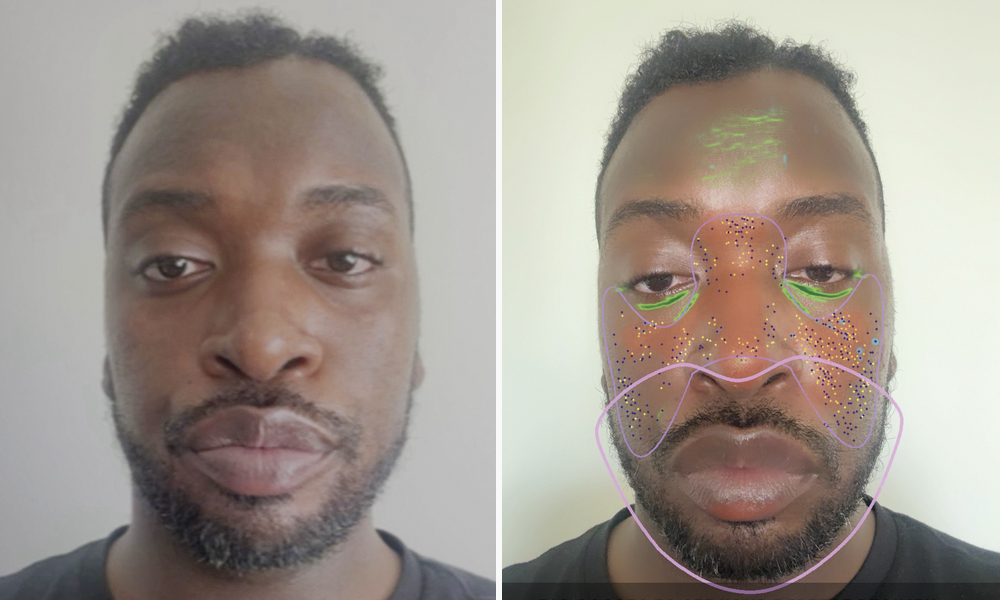I stand in front of the bathroom mirror and take a selfie. Not for Instagram, but for artificial intelligence (AI). I decided to entrust my skincare journey to four key AI-powered tools. I decided to see what the tool could tell me about my face, my concerns, and (hopefully) give me some insight into the best products to use. From apps that promise personalized prescriptions based on a single photo to dermatologist-led quizzes, these platforms are quickly becoming the skincare industry’s newest hot topic.
But this is what bothers me. As a Black beauty writer with melanin-rich skin, I often wonder if these algorithms really apply to me. My skin concerns, including post-inflammatory hyperpigmentation (PIH), uneven texture, and scarring that is prone to keloids, go beyond aesthetics. They are tied to identity, culture, and biology. So I tried a popular AI skincare platform, then consulted two trusted dermatologists to sort out what works and what doesn’t. Here’s what I learned.
Each AI tool started out the same way, asking me to take a selfie in natural light, but the results were different. La Roche-Posay’s MyRoutine AI stood out by recognizing my dark spots as my biggest concern and offering a complete routine tailored to my pigmentation, somehow making me feel seen. Vichy’s SkinConsult AI also flagged pigmentation and mapped my face in detail, but the product suggestions felt more general than personalized. L’Oréal’s SkinGenius focused on shine, emphasized hydration and texture, but completely ignored pigmentation and PIH. Elemis’ virtual skin analysis took a more lifestyle-driven approach and provided user-friendly recommendations based on a wide range of concerns, but lacked clinical depth and completely ignored melanin-specific issues. Overall, these tools identified surface-level concerns such as lack of shine and firmness, but most failed to address the deeper needs of melanin-rich skin, especially hyperpigmentation and scarring.
To understand these mixed results, I consulted dermatologist Corey L. Hartman, MD, of Birmingham, Alabama, and dermatologist Michelle Henry, MD, of New York. Both doctors understand the power and limitations of AI in dermatology.
“AI tools like this, when properly trained, can be incredibly insightful,” says Dr. Henry. Think of it as triage, not diagnosis. ” This would explain why so many tools flagged dryness and sensitivity, but none even showed my pigmentation concerns. “Most datasets are still biased towards light skin tones,” adds Dr. Henry. “This means conditions such as PIH and keloids are often under-recognized.
Dr. Hartman agrees. “AI has the potential to quickly analyze skin changes and aid in diagnosis, but not yet in melanin-rich skin,” he says. “These tools cannot replace a visual and physical examination by a board-certified dermatologist.
Both experts are also wary of quiz-based personalization. Dr. Hartman believes this approach is a good starting point, but suggests that quizzes often fall short when it comes to follow-up questions and depth. Dr. Henry adds that while AI tools may be helpful for beginners, they are not comprehensive enough for people with more specific concerns or complex skin conditions.
As I evaluated the four tools I tried, a few things became clear. AI is great at picking up on a wide range of concerns, including dry spots, enlarged pores, and fine lines. These platforms also help newbies build a routine when they’re feeling overwhelmed at the drugstore. But what they missed was the vibrant texture of my skin, the scars from cystic breakouts, and my pigmentation, which appeared in clumps rather than patches. None of the tools asked people whether they had ever had keloids, whether they used certain skin care ingredients seasonally depending on the weather, or whether they participated in cultural grooming practices.
So how can AI actually support better skin care? Both experts say it starts with comprehensive data. Dr. Hartman emphasizes that for AI to be truly effective, it must be trained to suit your skin type and tone (such as rough or acne-prone skin). Dr. Henry added that transparency is equally important, noting that users have the right to know who is behind the technology and how it is being developed.
They also believe that dermatologists of color and culturally competent developers must have a seat at the table and build tools from the ground up. That’s the only way to move beyond generalized advice to true personalization.
Why not use AI to check your skin care concerns? As a starting point, of course. These tools are fun, fast, and help you track surface-level changes and revitalize your routine. But they are no substitute for actual dermatological care, especially if you have melanin-rich skin, certain skin care habits, or long-standing concerns.
AI promises personalization, but its capabilities are currently limited. If the results don’t reflect who you are, trust your intuition. You are not invisible. Your skin is valid. Technology just needs to catch up. Until then, I’ll keep taking selfies and carefully applying serums, keeping my eyes on the experts who see everything about me, not just a pixelated version.





